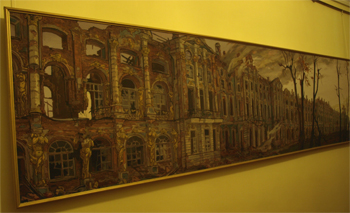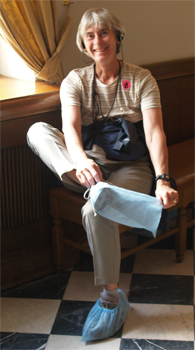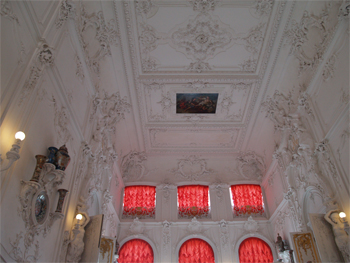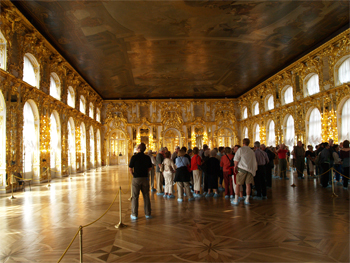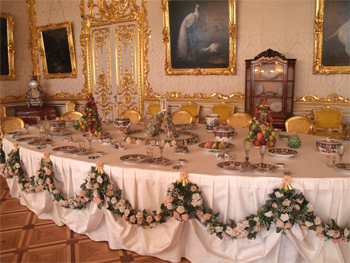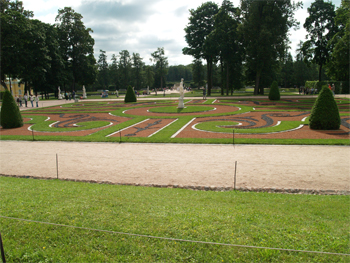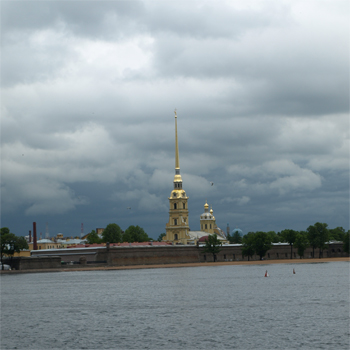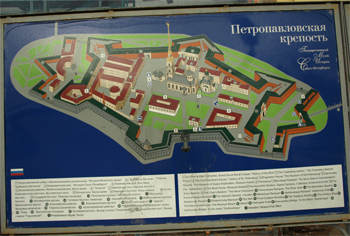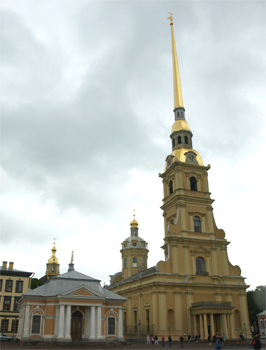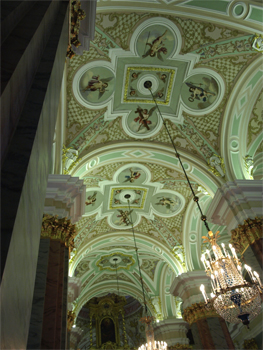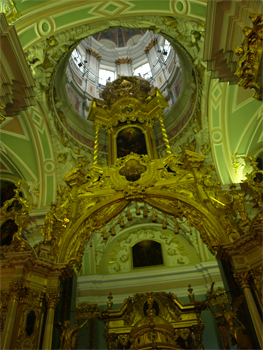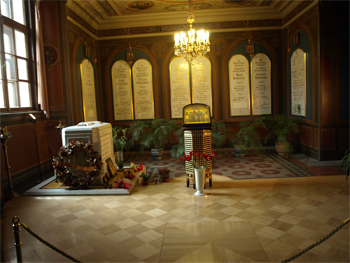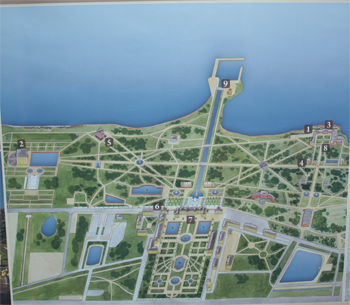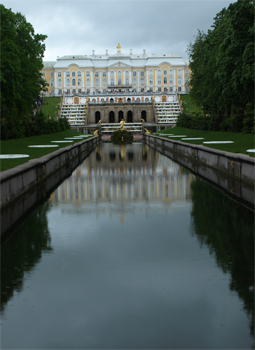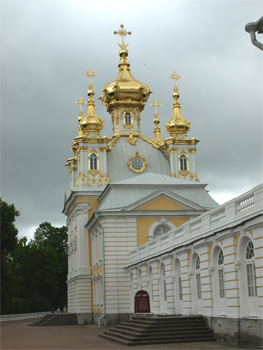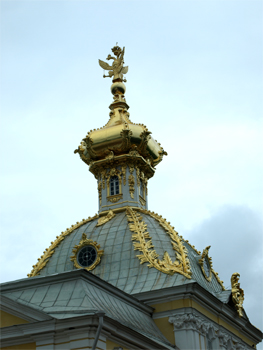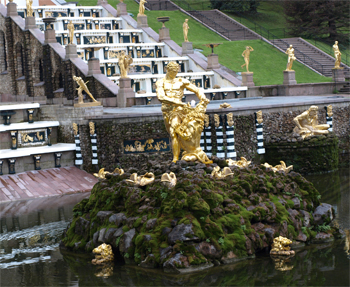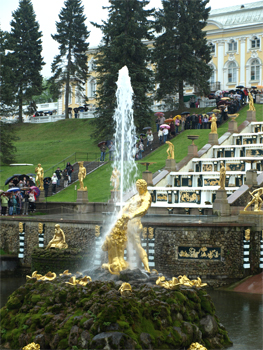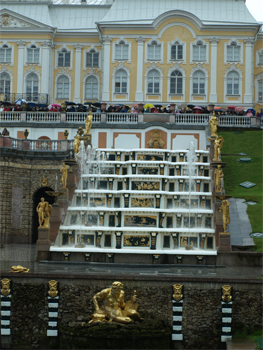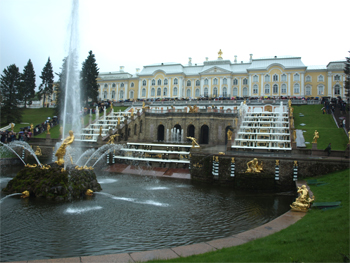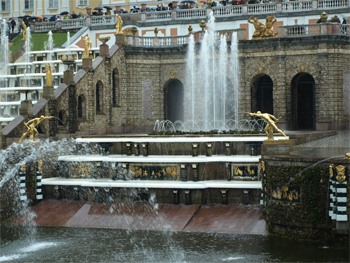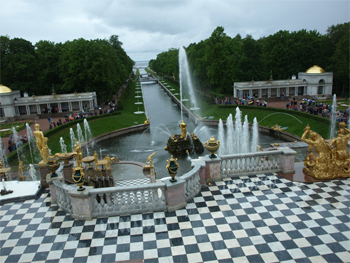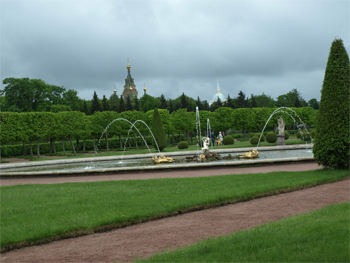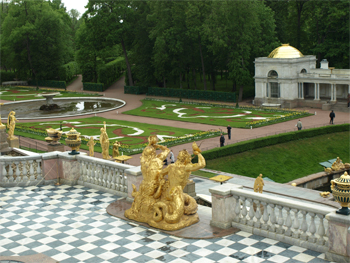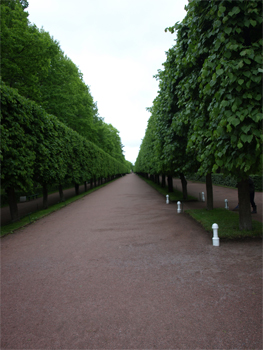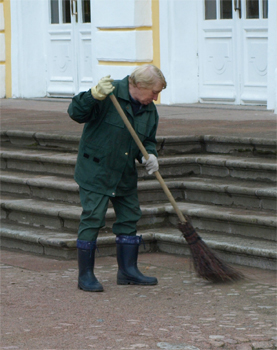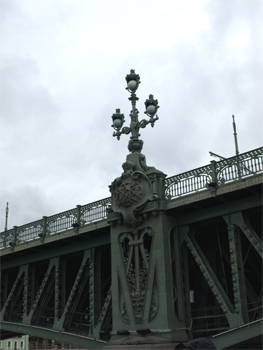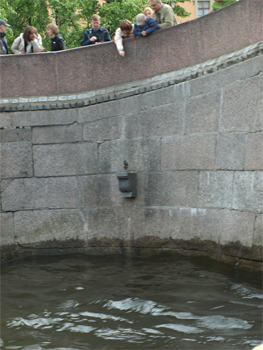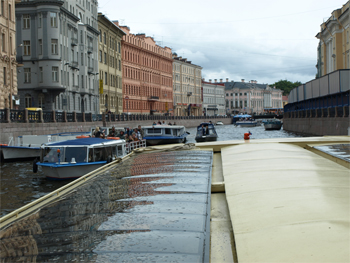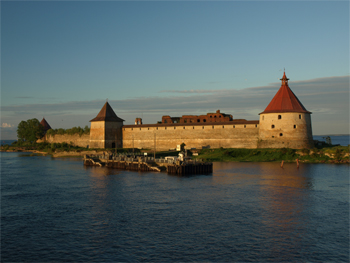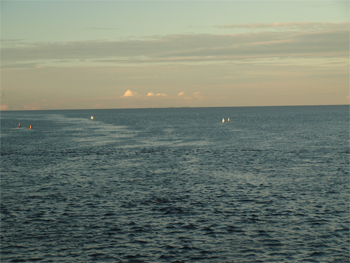It was a very short (and cold) night. We got up at 6 AM, dressed and went to the continental breakfast in the Panorama Bar on the next deck up. We had fruit, bread with meats and cheese and Danish and no hassles with the large crowd at the breakfast buffet in the dining room.
We boarded our bus at 7:30 AM; Natasha is our guide and Vladimir is our bus (a Mercedes coach) driver. At about 8:30 we were dropped off at the Catherine (or Summer) Palace in Pushkin which is 21 km south of St. Petersburg, higher in elevation and off the coast, thereby having more favorable weather than in the city, but not today. It rained all day and was only 10° Celsius. The rain doesn’t stop the locals - they are used to this weather, and much worse. We did bring warm clothes and rain jackets so we were almost comfortable.
Natasha explained things all along the route. We rode past land that was farmland and successful before communism, not successful during communism, and now is unplanted. She described potatoes that rotted in the field because of heavy rain so trucks couldn’t come in and carry them out. The Soviets commanded the trucks to wait until the ground froze to be able to get into the fields and didn’t care that then the potatoes could not be dug up. The workers didn’t care because there was no incentive to work harder than anyone else or to be successful.
The Catherine Palace is an ostentatious place. Most of the front of the building is covered in scaffolding for more ongoing (constant) restoration. We were again in awe of what the Germans did to this magnificent place during their 28 months of occupation during World War II. What wasn’t chopped up and used as firewood (elegant furnishings, moldings, etc.) was simply destroyed out of hatred. The cathedral was used as a garage for motorcycles, cars, and tanks. The guest quarters were used as stables. Many of the pictures and some furniture were crated and shipped to Siberia before the Germans arrived and therefore were preserved. The buildings were burned down to the brick walls when the Germans left. There was no roof to keep out the snow and rain. In the last 20 years the amount of reconstruction and restoration (paid for by the “state budget”) is amazing. However, things are progressing slowly now because of the poorer economy and the age (elderly) of the skilled craftsmen doing the carvings, gilding, oil painting repair, etc.
|
Approach to the Catherine Palace |
Post World War II
|
Post World War II Given the amount of damage done by the Germans, it is a miracle that so much has been restored. |
Front of the palace |
Ornate, golden gates
|
|
Gale putting on the protective booties. As with the Hermitage, every surface is covered with works of art - walls, floors, ceilings, etc. The Amber Room and the grand reception hall are opulent beyond belief. No photos are allowed in the Amber Room and the room itself is a reconstruction as the original amber walls, etc. disappeared during the War and have yet to be found.
|
Entry Hall
|
Ballroom |
State dining room
|
A study - the blue Delft tile structure is a stove for heating the often drafty room - many rooms in the palace have these beautiful stoves
|
We took a very short walk in the gardens, in the rain, to see Catherine’s philosophy/gallery wing, the bathhouse, the boat house and man-made lakes and flower gardens. The workers/gardeners (men and women) were out in raincoats raking linden and lilac leaves, removing spent tulips bulbs, turning rich black soil for new plantings. Since it rains a lot here (300 days a year) they are used to working in it.
|
|
We rode back into the city and Natasha described the Leningrad Siege to us. For 900 days (from September 8, 1941 to January 27, 1944) the citizens kept the Germans out of Leningrad (St. Petersburg) but they had no food (they had eaten all the cats, dogs, and horses), no water (they drank water from the muddy Neva River), no heat (they burned all their furniture and books, but never cut down the trees in the city) and they died of starvation (estimates range from 641,000 to close to 800,000 people). They buried their dead in common graves, 1,000 to a hole. Those who survived did so on a ration of bread the size of a matchbox a day. They covered statues and chandeliers in sand to protect them from the relentless German shelling. They painted cathedral spires gray to match the sky so they were camouflaged from the front lines. Natasha suggested several books to read on the subject. (http://www.saint-petersburg.com/history/siege.asp)
We cannot imagine what these people went through in the last 75 years. And then the Bolsheviks destroyed churches and left only one Baptist, one monastery, 15 Russian Orthodox, one mosque, etc. not torn down or burned. And then the Soviets ruined their lives. For instance, Khrushchev visited the US and saw us growing corn, came back to Russia and declared that the collective, state owned farms would plant corn. It was like planting corn in Antarctica! Natasha is giving us a new perspective on all things Russian. She was educated here at the university and was allowed to be a tour guide under the Soviet regime. She was taught what she could tell the few tourists who were allowed to visit the very limited areas to impress visitors with how wonderful communism was. She was well paid and continued to collect the same salary from Sept. to May when there were no tourists and there was only the one state run tour company, Intourist. There are now 600 Russian tour companies and she is free to choose the one she wants to work for and what she can say to tourists and what feelings she wants to express. She likes now better. Young people have a good education, good jobs (many with foreign companies), and a positive outlook.
Our next stop was back in the city at the Fortress of Sts. Peter and Paul. The fort was built in the early 1700’s to protect the city from enemy ships sailing in and up the Neva River. The fortress was later used as a prison for political prisoners and now includes the Russian mint and the Cathedral of Sts. Peter and Paul.
|
Fortress of Sts. Peter and Paul from across the Neva
|
Plan of the Fortress
|
The cathedral is not used for regular worship but houses the crypts of the various Russian czars: Peter the Great, Catherine the Great, Dagmar, Nicholas, etc.
|
Cathedral interior
|
Cathedral interior |
Tombs of the Czars and Czarinas
|
Final resting place of the remains of the Romanovs in a special chapel in the Cathedral |
We entered a small chamber and listened to four men dressed as monks sing a Russian “Alleluia.” They were quite good, and of course sold CD’s at the inevitable gift shop in the tourist attraction. It rained the whole time we were at the fortress.
The next stop was lunch served at a “pectopah” or restaurant. (This is one Russian word we learned to recognize in Cyrillic.) We had a salad of peppers, cucumbers, and broccoli; a pasta like ravioli filled with mystery meats; and a cranberry/loganberry pastry.
We finally returned to the ship (3:30 PM) for some free time. We both took a well deserved two-hour nap, then showered before going to dinner. We ate with a couple we have talked to before. They are from Houston. Dinner was an interesting processed turkey rolled around a Russian variation of stuffing with green mashed potatoes, and bell pepper ragout or fried halibut with a mix of veggies. The hors d’oeuvre was an asparagus creation, then spinach and herb soup and “Swan Lake” (pastry with chocolate mousse and a swan head/neck) for dessert. Dinner was good and the preparation different from American cuisine.
Another early morning. We were on the bus at 7:45 AM and went southwest to the Peterhof Palace. We passed areas of “kitchen gardens,” like our victory gardens. They were small plots with little sheds for keeping tools. Some had glass or plastic hot houses. The gardens are an old tradition still maintained by many Russians.
We passed many dachas or summer cottages originally given as favors to dukes and lords. Most were two story wooden houses with lots of gingerbread and no chimneys - no heat needed in summer.
The area around Peterhof is favored by the “nouveau riche.” There were many large fancy houses and many in subdivisions like in the U.S. They even have taken the acreage of kitchen gardens and are making them into a golf courses.
We entered the Peterhof Palace, located on the Gulf of Finland, and toured it with Natasha as our guide for one hour. The rooms were opulent - silk wall “paper,” carved and gilded trimmings, paintings on the ceilings, parquet designed floors, intricate furniture, etc. (no photos allowed). All was ruined and burned during the WWII German occupation and has been carefully reconstructed since then. Pieces were hidden to be saved and allowed for much of the restoration. For instance, one chair of each set was hidden and the rest destroyed by the Germans. That one chair was then used to reconstruct the others to make a full set. We saw the throne rooms and anterooms and waiting rooms, the czar’s bedchambers and the czarina’s quarters and dining rooms and ballrooms.
Map of the Peterhof Palace |
Palace as seen from the Gulf of Finland side
|
Peterhof Palace |
Peterhof Palace
|
Looking out toward the Gulf of Finland
|
Hovercraft approaching from across the Gulf of Finland |
The thing that makes this palace different, is the fountains and the gardens. At 11 AM the water channels are opened (by hand) and the water flows by gravity from 50 miles away into successively narrower pipes to create the force to shoot the water high in the fountains. It started to pour rain at 10:59 AM but Marge used the camera under my umbrella and got some good pictures. The main “cascade” was impressive.
|
Main fountain
|
Main fountain - water getting started
|
Main fountain |
Main fountain |
Main fountain
|
Main fountain |
Another fountain
|
Another fountain |
Intricate landscaping on the grounds
|
Formal row of linden trees |
Sweeping the grounds
|
We went back to the boat for a quick lunch and then back to our bus to take us to the dock for a trip on a canal boat through St. Petersburg. We cruised on the Neva River, the Fontanka Canal, the Moika River, and the Winter Canal while Natasha pointed out what was special about many of the buildings. It was an interesting view of the city.
Our canal boat |
Bridge adornments
|
Chizhik Pyzhik - one of the smallest monuments in the world - local tradition suggests that anyone who can toss a coin so that it lands on the statue without falling into the water is in line for some good luck.
|
Lots of traffic |
Many bridges with very low clearance
|
St. Petersburg trolley |
St. Petersburg has 42 islands, 500 bridges, is 10% water, is built on a swamp, and its city streets have been flooded 300 times in 300 years. The bridges over the Neva River (the last section of the Volga-Baltic Waterway) are all draw bridges except for the one near our ship that was opened in 2003. The drawbridges are open from 1 to 3 AM and 4 to 5 AM for boat traffic to pass. The river is only navigable from April to the end of October. However, it no longer freezes solid enough to drive on.
Back on the boat we got about an hour nap (we zonked!) and then went to the Sky Bar to meet the captain (who does not speak English) and crew, toasted him with our champagne, had our “safety briefing” - life jacket 101 - and then joined Charlie (the friend of Peggy and Patsy - and now us) and Charles and Jim for our welcome aboard dinner. The boat was moving up the Neva River as we left St. Petersburg and the sun began to shine!
At 10 PM (the sun will set around 11:15 PM and rise at 4:40 AM - we are on almost the same latitude as Anchorage, AK) it was bright and sunny out so we went on deck to see the Schlisselburg fortress founded in 1323 to guard the entry to Lake Ladoga, the largest lake in Europe. As we prepared for bed, the sun was still shining and we were in the huge lake.
Approaching the Schlisselburg fortress
|
Schlisselburg fortress |
Schlisselburg fortress and channel markers |
Entering Lake Ladoga
|
| Return to Top | Return to Itinerary | Return to Dreamcatcher Home Page |


